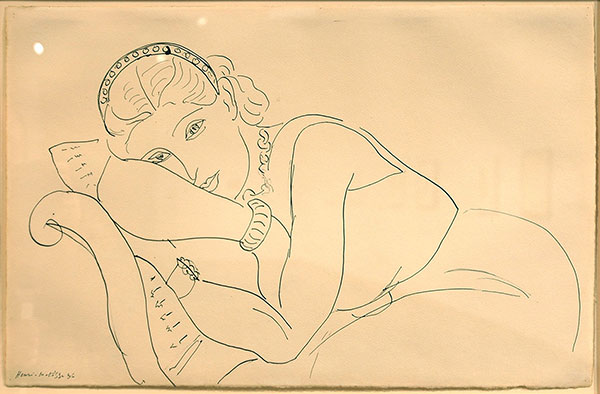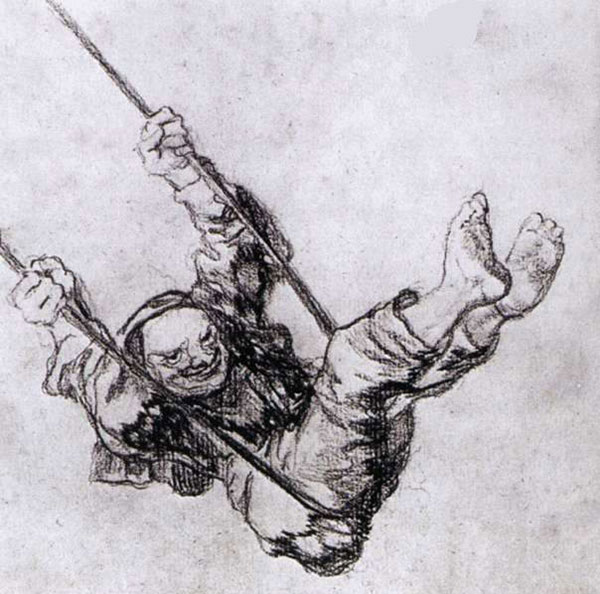As the 2012 Olympic Games get underway in London, we’ll have an opportunity to observe the elegance and power of the human body in action, diverse kinds of bodies honed through intensive training for different skills. Here I salute the occasion with my own studies of the body from figure drawing sessions at Figureworks Gallery in Brooklyn and Spring Studio in Manhattan. All of these sketches are made with watercolor and brush during sequences of two-minute poses. The illustrations are presented in random order, and the interspersed text is not specifically related to the adjacent images, but generally to the whole collection.
A sequence of quick poses is a kind of dance, as the model moves from one position to another to reveal the anatomical structure and the expressive range of the body. The artist has only a moment to capture whatever can be captured. I am fascinated by the variety and dynamism of quick poses – the models can do all sorts of things that would be impossible or painful to hold for even a five or ten minute pose. Knowing that the timer is relentlessly counting down, I enter into a mode of hyperfocused flow, my eyes and my brush both in constant and coordinated motion. The only way to get anything interesting is to work with swift efficiency.
Here I’m posting complete sequences, so you’ll see some awkward passages as well as some lovely bits of brushwork that reveal something true of the model’s aliveness or individuality. Every real brushstroke is a rough approximation of the ideal brushstroke into which the visual cortex is translating the forms it perceives. I’ve been practicing this for many years, so my approximations are pretty good when my focus is on. It’s more important that the lines be confident and expressive than that they be accurate. If I were to stop to measure or take a moment to step back and look critically at the sketch, I would hardly be able to get anything at all in two minutes. I have to go unhesitatingly with the flow, and trust the flow.
I look for curves – the curve of the spine, of the hip, of the neck, of the knee, and make each curve a stroke of the brush. I try to emphasize what makes each individual body unique, not to genericize the anatomy. That uniqueness is in the curves. The curve of one person’s hip is quite different from that of another’s hip. I always look for the physical idiosyncracies.
I generally omit or radically simplify faces, hair, hands and feet. Those parts of the body are detail traps, best saved for more leisurely studies. But they are also often key to the particular expression of a pose or model, so I try to get some indication of their angles. The direction of a gaze, the splay or curl of the fingers, the twist of an instep can be the detail that makes the pose come alive in the sketch. For me, angles and curves are practically the whole of quick drawing.
Quick poses are a special exchange of energy between model and artist. A set of quick poses gives the model an opportunity to perform, to stretch out, to test their limits, to offer contrasts of feeling or form. As the artist, I cannot let such a gift go unappreciated. When a model is really giving the energy, drawing is like dancing with a fantastically graceful or dynamic partner – complete abandon is the only appropriate response.
A kind of time dilation can occur during quick poses. From my own experience as a model, I can tell you that holding a challenging pose can make two minutes seem like an eon. For the artist, a pose that’s complicated to draw can make two minutes feel like a few seconds.
Observing angles is a quick way to see how one thing relates to another thing in space. When I’m doing quick sketches, I’m making lots of lines that I don’t draw. In my mind, I make lines between points to see how they relate in space. I check the angle going from nipple to nose, or from fold of elbow to bulge of heel, or from where the arm meets the leg to the pubic ridge. When all of those parts are in the right angular relations to each other in space, proportions will be a fair approximation of the reality.
Sometimes it’s easier to see curves and shapes and angles by looking at the negative spaces, the places where the body is not, and how those places relate to each other. Or the angles of the body may become clearer by seeing them in relation to straight lines such as a wall or surface, the pole the model holds or the wall on which he leans.
I’ve pored over anatomy books, assimilating as much structural understanding of the body as I can, but I depict only details I can see. The knowledge helps me to grasp these features of the body, but I can’t get lost in an analytical breakdown of the body. I try to get as many anatomical details into the sketches as I can, because these details individualize the body.
Curves and angles, negative spaces, spatial relationships, anatomical details, flow and rhythm – it’s a lot to see and a lot to try to depict in two minutes. The only way to do it is to merge perceiving and drawing into a unified process. This is achieved by trying and trying and refining through hundreds of hours of practice.
When you watch an Olympic gymnast, you are seeing someone who has developed a perfect unity of perception and action through relentless practice. Drawing is more subjective, but the learning process is similar. All the details have to come together, to become one act.
All of the original sketches in this post are made with watercolor and a brush in 18″ x 24″ sketchbooks. Multiple pages have been stacked vertically in the illustrations so a whole series of quick poses appear in a single image, as though the drawings were made on a scroll. Action sketches actually made on scrolls, drawn by me more than a decade ago, can be seen in this post. I have also written previously about the similarities between life drawing practice and athletic practice, here.





























































